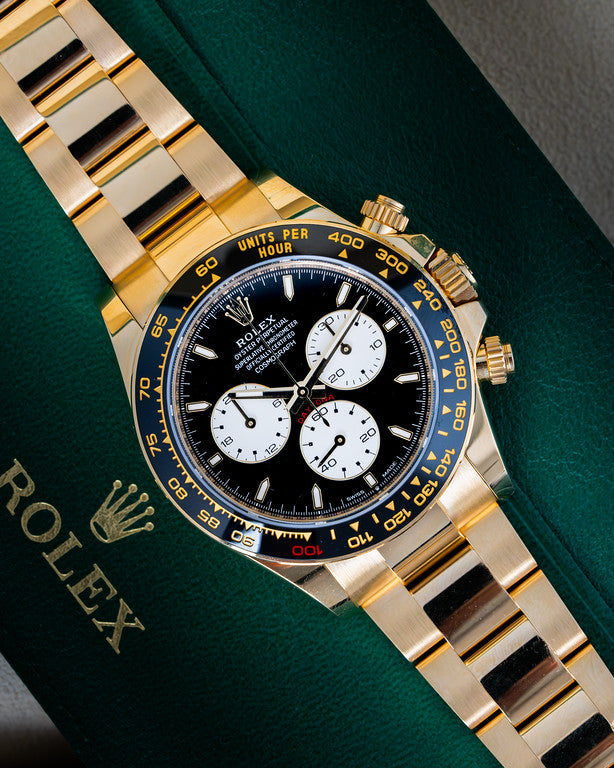Globally, the reputation of the prestigious, accurate, high-quality Rolex watch collection is well-known. Many, though, are interested in the internal workings of these timepieces and ask, "do Rolex watches tick?"
What Does It Mean to Tick or Sweep?
When talking about watches, one often wonders if they "tick" or "sweep." Let's define these two concepts before we dig into the specifics of a genuine Rolex watch.
The Standard Quartz Watch Movement

Most individuals have seen a ticking watch in which the second-hand advances and retracts precisely once every second, producing a noticeable "tick" sound with each motion. This sort of mechanism is prevalent in quartz timepieces.
Quartz watchmakers move the second hand using short, quick jumps. The tiny quartz crystal inside the watch is powered by a small battery, which is how the movement happens. To maintain track of time, the watch detects vibrations in the crystal and counts them. The distinctive ticking sound is created every second by the movement of the second hand.
Quartz timepieces are well-known for being accurate and reasonably priced. They are battery-operated, so unlike mechanical watches, they do not need to be wound.
The Mechanical Movement
By comparison, the second hand of a watch glides over the face of the watch in a sweeping motion without jerking from one second to the next. Mechanical timepieces, especially those from big brands like Rolex, often show this quality.
How does it work?
Mechanical timepieces do not need batteries. Instead, the hands are powered by a mechanism that uses gears and springs. Instead of jumping a single frame per second, the second hand of a mechanical watch glides fluidly from one position to another.
Do Rolex Watches Tick or Sweep?
Do Rolex watches tick or sweep?
Yes, these top watches do; in fact, they tick in a sweeping motion. Their distinctive sweeping movement sets them apart from quartz watches, which only tick once every second.
The Rolex Movement: The Secret Behind the Sweep
The second hand of the watch sweeps rather than ticks because watches by Rolex have a mechanical movement, particularly an automatic movement. Automated timepieces wind themselves as you wear them.
This feature gives them another name: self-winding. The watch is battery-free since it is powered by your wrist movement. Below are some other important parts of the model:
The Balance Wheel
Rolex collections rely on the balance wheel, an integral component of their movements. This little wheel that swings in and out controls the action of the watch's hands. The oscillation frequency in a Rolex's balance wheel is about 28,800 beats per hour. This results in the trademark Rolex sweep second-hand movement, which occurs eight times each second.
Caliber 3135:
The long-lasting and precise Caliber 3135 movement powers many Rolex watches. For many years, this caliber has been an integral element of these watches, and it is one of the main reasons why the brand is loved by watch enthusiasts worldwide.
Does a Rolex Tick at All?
Even though it may not seem like it, watches by Rolex indeed "tick”, but just not in the way you’d think!
Although they lack the precise timing of a quartz watch, the watch's second hand moves a great number of times per second, although in very small increments. The rapidity and diminutive size of these motions give the impression of a continuous sweep.
Pay close attention to a Rolex, and you might be able to make out a little ticking noise. The inner workings of the watch's balance wheel produce this sound. But compared to the ticking of a quartz watch, it's hardly audible.
The Difference Between Quartz and Mechanical Movements

Now that we know Rolex watches tick, we can compare and contrast mechanical and quartz movements. These differences are essential if you want to understand what makes a Rolex super watch unique.
Quartz Watches: Accurate and Affordable
A tiny quartz crystal and a battery are the two main components of this watch. The exact vibrations of the quartz crystal give these watches their reputation for accuracy. While mechanical watches are loaded with elegance and sophistication, quartz ones are more affordable, but lack that quality.
-
Pros:
-
Extremely accurate
-
Low maintenance
-
Affordable
-
-
Cons:
-
Lack of craftsmanship
-
Not as prestigious as mechanical watches
-
Mechanical Watches: Precision and Craftsmanship
Rolex and other mechanical timepieces do not use batteries. Instead, they keep time using a system made up of gears and springs. Due to the great degree of artistry required to manufacture them, these timepieces are typically priced higher than quartz ones. This quality is most obviously shown by the sweeping second hand when mechanical watches tick.
-
Pros:
-
Handcrafted precision
-
Smooth, sweeping motion
-
Longevity and durability
-
-
Cons:
-
More expensive
-
Requires regular maintenance and servicing
-
Rolex’s History with Quartz Watches
Rolex may be best known for its mechanical timepieces, but they did make quartz models for a short while. The Oysterquartz line was released by Rolex in the 1970s, coinciding with the heyday of quartz technology. These timepieces ticked rather than swept because they had a quartz movement.
The Rolex Oysterquartz
Rolex debuted the Oysterquartz in response to the 1970s quartz revolution. Quartz watches were becoming rather popular at that time because of their reasonable cost and accuracy.
Although its watches are usually mechanical, Rolex wants to give their consumers options including a quartz movement. Because of its unusual quartz movement, the Oysterquartz distinguished themselves from other Rolex models. This lets the second hand, like other quartz timepieces, run at one every second.
Production of the Oysterquartz lasted from the late '70s to the beginning of this millennium. Despite its high quality and accuracy, Rolex eventually discontinued the production of quartz watches. The Oysterquartz is now a highly sought-after collectible!
Why Rolex Stopped Making Quartz Watches
For several reasons, Rolex shifted its focus back to mechanical watches, even though quartz watches were popular. Below we have discussed a few of them:
Brand Identity
Watches by Rolex are famously well-made and expertly engineered. Producing timepieces of exceptional quality by hand has long been a point of pride for the business. This image was not going well with quartz watches.
Luxury Market
Mechanical timepieces are more opulent and distinguished than quartz ones. Rolex aspired to continue being the preeminent manufacturer of high-end timepieces.
Why the Sweeping Motion Matters?
The sweeping, elegant motion of a Rolex watch is more than skin deep. It represents the unwavering dedication of the brand to excellence and accuracy. However, what gives the sweeping motion its significance?
Have a look below:
Precision and Accuracy
Accuracy is the hallmark of every Rolex watch. The movement's high beat rate (28,800 beats per hour) enables very precise timekeeping. A watch's accuracy is proportional to how smoothly its second hand operates. Rolex stands out from other watch companies due to its meticulous attention to detail.
Luxury and Craftsmanship
Additionally, the graceful movement is just unbeatable. Quartz watches are more commonly related to mass production and low prices, whereas mechanical watches are more generally associated with handiwork and heritage. The sweeping second hand is a visual illustration of the sophisticated engineering inside a Rolex.
Durability and Longevity
Properly maintained mechanical watches have a lifetime of decades. A Rolex's perfect movement embodies its outward look, dependability, and long-lasting technology. Many Rolex watch owners see their timepieces as heirlooms, and the broad second hand constantly reminds them of the classic watch design.
Methods for Identifying a Fake Rolex
People often examine the workings of Rolex's second-hand movement to determine its authenticity. If the second hand ticks, some think the watch is fake because real Rolex timepieces sweep.
However, how trustworthy is the "tick test"? Let's find out!
The Myth of the Tick Test
A flowing second hand is a hallmark of most Rolex watches tick test, although it is not always an indicator of authenticity. If made well, fake watches can pass for the real thing... Yes, you read that right!
Actually, the second hand of certain counterfeit watches looks like it sweeps, much like the one on a real Rolex Submariner.
Better Ways to Spot Fake Rolex Watches

There are alternative methods to determine if a Rolex is authentic or not, rather than depending on the tick test. Here is how:
Weight and Material Quality
Verifying the watch's weight is a simple approach to identifying a knockoff Rolex. The heavier and more long-lasting 904L stainless steel used to construct authentic Rolex watches is only one example of the high-quality materials utilized in their construction. A fake Rolex could be too light to be authentic.
Engraving and Details
Exact and intricate engravings are hallmarks of a genuine Rolex. Make sure all of the markings on the watch, including the serial number and model number, are legible and sharp. Engravings on counterfeit timepieces are sometimes of low quality, with illegible or irregularly spaced numerals or letters. Look for these markings in the space between the lugs.
Cyclops Lens Magnification
A Cyclops lens magnifies the date window found on a Rolex watch 2.5 times. On a real Rolex, the date should be huge and clear. A trademark of fake Rolex watches, a Cyclops lens either misaligns or amplifies the date insufficiently.
Smooth Case Back
Except for the older models like the Datejust and Submariner, most authentic Rolex watches have a smooth back. If the case back is transparent, exposing the movement, or if the watch has visible engravings or symbols, it is rather possible that the watch is an original Rolex.
Though some true Rolex models, like the Sea-Dweller, have distinctive engraving on the rear of the case, always check using official Rolex information.
Movement Examination
The best way to spot a fake Rolex is to inspect the watch's mechanism closely. Opening the casing and looking at the movement requires the knowledge of a qualified specialist. While mass-produced, low-quality movements devoid of detailed engravings may be used in counterfeit Rolex watches tick, real Rolex watches have very high-quality, complex mechanisms.
The Fascination with Rolex: More Than Just a Watch
Though they are prestige symbols in themselves, Rolex watches are about luxury, accuracy, and achievement. The general movement of the brand is only one of many appealing features, which is one of several reasons Rolex is still among the most sought-after watch brands worldwide.
Rolex’s Reputation for Quality

Rolex has developed a reputation for producing consistent timepieces over the years. Renowned in the watchmaking industry, they invented the first waterproof watch (the oyster) and self-winding technology for automatic motions, the Perpetual.
A Status Symbol
Wearing a Rolex on your wrist signifies your achievements and success. Major attractions for many watch purchasers are Rolex's accuracy and reputation. Because of its reputation, a Rolex represents success and accomplishment for many people.
Timeless Design
Rolex watches feature a timeless style that will always be in vogue. As proof of their timeless allure, certain Rolex models, such as the Submariner and the Day-Date, have stayed mostly unchanged for decades. All it takes to recognize one of these watches is a glance at its classic dial design, solid construction, and clean lines.
How to Care for Your Rolex
If you want your Rolex to keep working for years and retain its worth, you should take good care of it. Due to their mechanical movement, Rolex watches require more upkeep than quartz watches. Here is what you can do:
Regular Servicing
If you own a Rolex, the brand suggests getting it serviced every 5 to 10 years. This entails bringing it to a certified Rolex service center, where an expert will inspect the mechanism, repair any broken components, and clean the movement to ensure the watch is functioning properly. Regular servicing ensures smooth operation and protection from wear and tear.
Winding Your Rolex
Winding your Rolex every so often will keep it operating well, even if you don't wear it every day. As you wear a Rolex, the watch will wind itself thanks to its automated movement. On the other hand, your Rolex can break if left unused for an extended period of time. A quick removal of the crown and a few rotations will wind your Rolex.
Cleaning the Watch
Regular cleaning will help your Rolex stay in pristine condition. To achieve this, just run the watch under some lukewarm water and give it a little scrape with a toothbrush. Thoroughly wipe it dry using a microfiber cloth. You can clean your watch more vigorously if it is waterproof (like a Submariner), but be careful with versions that aren't water resistant.
Conclusion
Ultimately, Rolex watches stand out from most other timepieces mostly in their sweeping motion. Rolex's in-house calibers, like the world-famous Caliber 3135, and automatic and mechanical motions help to enable the smooth operation of the second hand.
Unlike a quartz watch, which only ticks once every second, the second hand of an authentic Rolex watch seems to sweep steadily and continually. This is because of the high-frequency balance wheel. Regarding horology, Rolex watches are quite prized because of their excellent movements, which represent elegance and workmanship.
After testing quartz movements in its Oysterquartz range, Rolex has returned to mechanical watches, which are more valued and sought after. Beyond mere timepieces, Rolex watches are symbols of excellence; the sweep second hand is merely one of several unique features.





